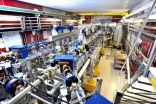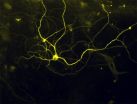(Press-News.org) LA JOLLA, CA--November 24, 2014--A team led by scientists from The Scripps Research Institute (TSRI) has found a simple method to convert human skin cells into the specialized neurons that detect pain, itch, touch and other bodily sensations. These neurons are also affected by spinal cord injury and involved in Friedreich's ataxia, a devastating and currently incurable neurodegenerative disease that largely strikes children.
The discovery allows this broad class of human neurons and their sensory mechanisms to be studied relatively easily in the laboratory. The "induced sensory neurons" generated by this method should also be useful in the testing of potential new therapies for pain, itch and related conditions.
"Following on the work of TSRI Professor Ardem Patapoutian, who has identified many of the genes that endow these neurons with selective responses to temperature, pain and pressure, we have found a way to produce induced sensory neurons from humans where these genes can be expressed in their 'normal' cellular environment," said Associate Professor Kristin K. Baldwin, an investigator in TSRI's Dorris Neuroscience Center. "This method is rapid, robust and scalable. Therefore we hope that these induced sensory neurons will allow our group and others to identify new compounds that block pain and itch and to better understand and treat neurodegenerative disease and spinal cord injury."
The report by Baldwin's team appears as an advance online publication in Nature Neuroscience on November 24, 2014.
In Search of a Better Mode
The neurons that can be made with the new technique normally reside in clusters called dorsal root ganglia (DRG) along the outer spine. DRG sensory neurons extend their nerve fibers into the skin, muscle and joints all over the body, where they variously detect gentle touch, painful touch, heat, cold, wounds and inflammation, itch-inducing substances, chemical irritants, vibrations, the fullness of the bladder and colon, and even information about how the body and its limbs are positioned. Recently these neurons have also been linked to aging and to autoimmune disease.
Because of the difficulties involved in harvesting and culturing adult human neurons, most research on DRG neurons has been done in mice. But mice are of limited use in understanding the human version of this broad "somatosensory" system.
"Mouse models don't represent the full diversity of the human response," said Joel W. Blanchard, a PhD candidate in the Baldwin laboratory who was co-lead author of the study with Research Associate Kevin T. Eade.
A New Identity
For the new study, the team used a cell-reprogramming technique (similar to those used to reprogram skin cells into stem cells) to generate human DRG-type sensory neurons from ordinary skin cells called fibroblasts.
To start, the scientists examined previous experiments and identified several transcription factors--managerial proteins that switch on the activity of large sets of genes--that seemed crucial to the ability of immature neurons to develop into adult sensory neurons. They found that the combination of the transcription factors Brn3a plus Ngn1, or Brn3a plus Ngn2, reprogrammed a significant percentage of the embryonic mouse fibroblasts into what looked--and acted--like mature DRG-type sensory neurons.
"We added compounds including capsaicin, which activates pain receptors on DRG neurons, and menthol, which activates cold receptors, and saw subsets of our induced neurons light up with activity just as real DRG neurons would," said Eade.
Remarkably, although mouse studies had indicated that different transcription factors were differently important for generating pain- and itch-sensing neurons versus pressure- and limb- position neurons, in the dish these factors produced equal numbers of each of the three main subtypes.
A Step Toward 'Personalized Medicine'
Using the same recipes of transcription factors, the team was able to convert adult human fibroblasts, which are harder to reprogram, into DRG neurons. The conversion rate was lower, but the induced neurons seemed just as much like their natural counterparts as those produced from embryonic mouse fibroblasts.
"We can definitely scale up of the numbers of these induced neurons as needed," Blanchard said.
The feat means that scientists now can relatively easily study DRG sensory neurons derived from many different people to better understand the diversity of human sensory responses and sensory disorders and advance a "personalized medicine" approach. "We can start to understand how individuals respond uniquely to pain, cold, itch and so on," said Blanchard.
INFORMATION:
Other co-authors of the study, "Selective conversion of fibroblasts into peripheral sensory neurons," were Valentina Lo Sardo, Rachel K. Tsunemoto, Daniel Williams and Pietro Paolo Sanna, all of TSRI; and Attila Szűcs of the University of California San Diego, who performed many of the electrical tests on the induced neurons.
Support for the research came from the Dorris Neuroscience Center, the California Institute of Regenerative Medicine, the Baxter Family Foundation, the Del Webb Foundation, The Norris Foundation, Las Patronas, the National Institutes of Health National Institute on Drug Abuse (DA031566), National Institute on Deafness and other Communication Disorders (DC012592) and National Institute of Mental Health (MH102698)), the National Science Foundation and the Andrea Elizabeth Vogt Memorial Award.
ANN ARBOR--Our bones are smart. Bones know that by adolescence it's time to stop growing longer and stronger, and from that point on bones keep their shape by healing injuries.
This question of why bones grow longer and stronger in children, but stay static in adults--yet retain the ability to heal themselves, has long perplexed scientists in the bone regeneration field. But researchers from the University of Michigan, Kyoto University and Harvard University believe they may have unearthed a big piece of this puzzle.
The team discovered that a certain subset of cartilage-making ...
VIDEO:
When zebrafish are infected with bright blue Mycobacterium marinum, bright red immune cells quickly surround the bacteria to form tightly organized nuggets called granulomas (vessels green, bacteria blue, immune cells...
Click here for more information.
DURHAM, N.C. -- The body responds to tuberculosis infection by locking the bacterial offenders into tiny clusters of immune cells called granulomas, which are a hallmark of the disease. This containment strategy succeeds ...
The structure of pores found in cell nuclei has been uncovered by a UCL-led team of scientists, revealing how they selectively block certain molecules from entering, protecting genetic material and normal cell functions. The discovery could lead to the development of new drugs against viruses that target the cell nucleus and new ways of delivering gene therapies, say the scientists behind the study.
At the heart of every cell in our body is a cell nucleus, a dense structure that contains our DNA. For a cell to function normally, it needs to surround its nucleus with a ...
The first detailed, high-resolution 3-D maps of Antarctic sea ice have been developed using an underwater robot. Scientists from the UK, USA and Australia say the new technology provides accurate ice thickness measurements from areas that were previously too difficult to access.
The results, published this week in the journal Nature Geoscience (Monday 24 November 2014), step up the pace of research in the polar regions aimed at understanding the dramatic sea ice changes in the context of climate change.
Scientists use a range of technologies and techniques to measure ...
Scientists have discovered a gene that protects people against one of the major causes of stroke in young and middle-aged adults and could hold the key to new treatments.
Researchers from Royal Holloway, University of London, together with an international team from across the United States and Europe, have found that people with a specific variant of a gene, known as PHACTR1, are at reduced risk of suffering cervical artery dissection, which is caused by a tear in an artery that leads to the brain.
The new discovery, published in the journal Nature Genetics, could ...
Scientists at the Helmholtz-Zentrum Dresden-Rossendorf (HZDR) have studied the dynamics of electrons from the "wonder material" graphene in a magnetic field for the first time. This led to the discovery of a seemingly paradoxical phenomenon in the material. Its understanding could make a new type of laser possible in the future. Together with researchers from Berlin, France, the Czech Republic and the United States, the scientists precisely described their observations in a model and have now published their findings in the scientific journal Nature Physics.
Graphene ...
Boston, MA - Researchers at Harvard School of Public Health (HSPH) have found a novel mechanism causing type 2 diabetes that could be targeted to prevent or treat the disease. The research highlights a previously unrecognized molecular pathway that contributes to the malfunction of liver cells in obesity, leading to insulin resistance and diabetes.
The study appears online November 24, 2014 in Nature Medicine.
"While it is well-established that obesity generates cellular and molecular stress leading to abnormal functioning of many cellular processes, the mechanisms ...
CAMBRIDGE, MA -- Researchers have made great progress in recent years in the design and creation of biological circuits -- systems that, like electronic circuits, can take a number of different inputs and deliver a particular kind of output. But while individual components of such biological circuits can have precise and predictable responses, those outcomes become less predictable as more such elements are combined.
A team of researchers at MIT has now come up with a way of greatly reducing that unpredictability, introducing a device that could ultimately allow such ...
After more than six years of intensive effort, and repeated failures that made the quest at times seem futile, Harvard Stem Cell Institute (HSCI) researchers at Boston Children's Hospital (BCH) and Harvard's Department of Stem Cell and Regenerative Biology (HSCRB) have successfully converted mouse and human skin cells into pain sensing neurons that respond to a number of stimuli that cause acute and inflammatory pain.
This "disease in a dish" model of pain reception may advance the understanding of different types of pain, identify why individuals differ in their pain ...
Cloaking immune cells with antibodies that block T cell trafficking to the gut can substantially reduce the risk of viral transmission in a non-human primate model of HIV infection, scientists report.
The findings suggest that drugs that are already in clinical trials for inflammatory bowel diseases might be effective in the treatment or prevention of HIV infection.
The results are scheduled for publication in Nature Medicine.
"We were surprised by the effects that we observed," says senior author Aftab Ansari, PhD, professor of pathology and laboratory ...





